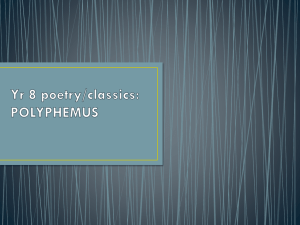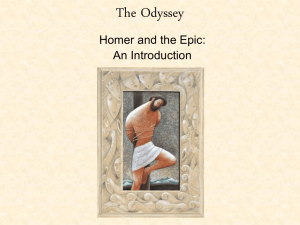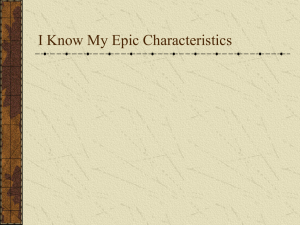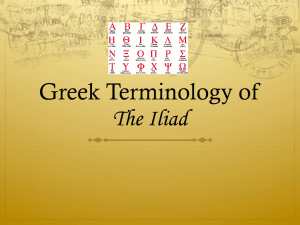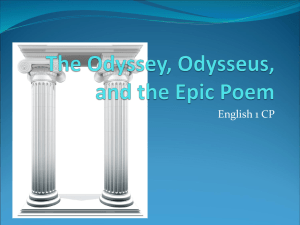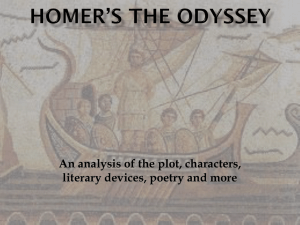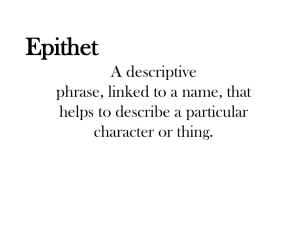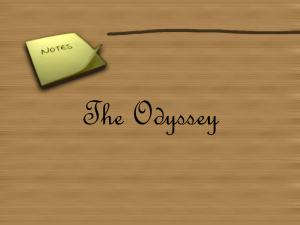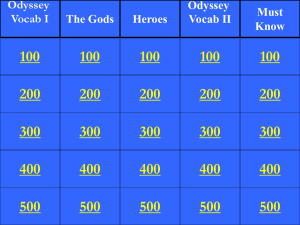second year creative writing epic
advertisement
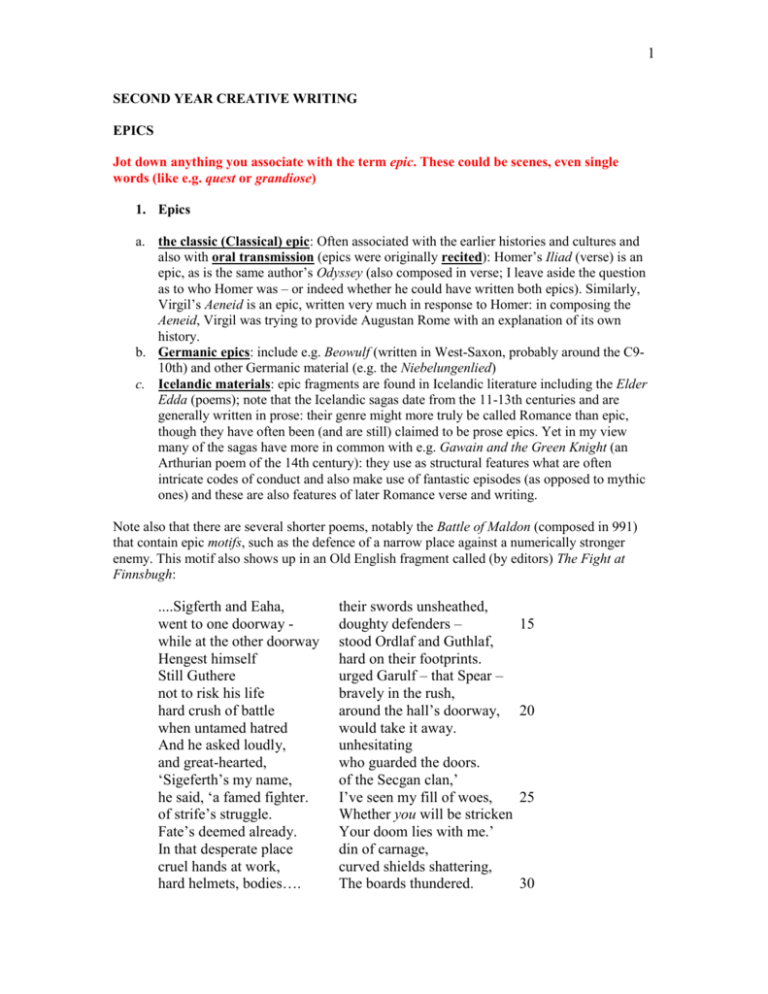
1 SECOND YEAR CREATIVE WRITING EPICS Jot down anything you associate with the term epic. These could be scenes, even single words (like e.g. quest or grandiose) 1. Epics a. the classic (Classical) epic: Often associated with the earlier histories and cultures and also with oral transmission (epics were originally recited): Homer’s Iliad (verse) is an epic, as is the same author’s Odyssey (also composed in verse; I leave aside the question as to who Homer was – or indeed whether he could have written both epics). Similarly, Virgil’s Aeneid is an epic, written very much in response to Homer: in composing the Aeneid, Virgil was trying to provide Augustan Rome with an explanation of its own history. b. Germanic epics: include e.g. Beowulf (written in West-Saxon, probably around the C910th) and other Germanic material (e.g. the Niebelungenlied) c. Icelandic materials: epic fragments are found in Icelandic literature including the Elder Edda (poems); note that the Icelandic sagas date from the 11-13th centuries and are generally written in prose: their genre might more truly be called Romance than epic, though they have often been (and are still) claimed to be prose epics. Yet in my view many of the sagas have more in common with e.g. Gawain and the Green Knight (an Arthurian poem of the 14th century): they use as structural features what are often intricate codes of conduct and also make use of fantastic episodes (as opposed to mythic ones) and these are also features of later Romance verse and writing. Note also that there are several shorter poems, notably the Battle of Maldon (composed in 991) that contain epic motifs, such as the defence of a narrow place against a numerically stronger enemy. This motif also shows up in an Old English fragment called (by editors) The Fight at Finnsbugh: ....Sigferth and Eaha, went to one doorway while at the other doorway Hengest himself Still Guthere not to risk his life hard crush of battle when untamed hatred And he asked loudly, and great-hearted, ‘Sigeferth’s my name, he said, ‘a famed fighter. of strife’s struggle. Fate’s deemed already. In that desperate place cruel hands at work, hard helmets, bodies…. their swords unsheathed, doughty defenders – stood Ordlaf and Guthlaf, hard on their footprints. urged Garulf – that Spear – bravely in the rush, around the hall’s doorway, would take it away. unhesitating who guarded the doors. of the Secgan clan,’ I’ve seen my fill of woes, Whether you will be stricken Your doom lies with me.’ din of carnage, curved shields shattering, The boards thundered. 15 20 25 30 2 Garulf was first deprived its hosts, of Guthlaf’s son, became corpses. circled, sallow-feathered. as if all Finnsburg I’ve never yet heard tell than those sixty souls endowed, nor of the merit so deserving, than those men Five days they fought: Those fierce kinsmen One warrior then his corslet sheared, shattered, helmet-front to fall. Combat those perishable ones, and a good many with him Now the carrion-raven Sword-light flickered were flame-riddled. of truer warriors so courageously of dewy mead whose mettle was Hnaef’s. five days. None fell. kept defending the doors. went on his way – he said, armour holed by the encounter... 35 40 (trans. Chris McCully, Old English Poems and Riddles, Carcanet 2008) ....He drew up his battle-line on Blackwater’s banks. All his army stood on the eastern shore. But the tide kept apart the two forces – the flood still flowed, full after ebb, the twined currents. Too long it seemed before they could marry their spears in mortal combat. Army from longships; East-Saxon mettle: ranged on the riverbank, arrayed for war. Yet no man could cause any mutual hurt unless an arrow was unloosed, took life as it fell. The tide went out. The Viking troop – a warrior host waited, were ready. Byrhtnoth then commanded a battle-hardened warrior named Wulfstan to ward the causeway – the quickest of his clan, Ceola’s young son. He overtoppled an adversary who’d boldly advanced, ventured the crossing-place. With Wulfstan stood those sternest thanes Aelfere and Maccus avid, valorous pair – who were determined never to turn from the ford but to defend it fiercely against its attackers as long as they could carry weapons in combat. When they discovered, when their cruel eyes saw death waited there on that dangerous ford, then the unwelcome guests used guile, taunting, wheedling for access, asking for passage across the fateful causeway for their foot-soldiers. It was then that Byrhtnoth - brave, but too magnanimous – allowed access to the longships’ host.... 65 70 75 80 85 90 3 (trans. Chris McCully, Old English Poems and Riddles, Carcanet 2008) The world of these epics is aristocratic and heroic. Key relationships involve the loyalties – often, complex loyalties – between central protagonist/hero and his men. It’s a strange fact that there are very few epics written by women, and certainly not in the Classical or Germanic phases of epic. d. In later literary history, also be aware that there are mock-epics. mock-epic, also called mock-heroic, form of satire that adapts the elevated heroic style of the classical epic poem to a trivial subject. The tradition, which originated in classical times with an anonymous burlesque of Homer, the Batrachomyomachia (Battle of the Frogs and the Mice), was honed to a fine art in the late 17th- and early 18th-century Neoclassical period. A double-edged satirical weapon, the mock-epic was sometimes used by the “moderns” of this period to ridicule contemporary “ancients” (classicists). More often it was used by “ancients” to point up the unheroic character of the modern age by subjecting thinly disguised contemporary events to a heroic treatment. The classic example of this is Nicolas Boileau’s Le Lutrin (1674–83; “The Lectern”), which begins with a quarrel between two ecclesiastical dignitaries about where to place a lectern in a chapel and ends with a battle in a bookstore in which champions of either side hurl their favourite “ancient” or “modern” authors at each other. Jonathan Swift’s “Battle of the Books” (1704) is a variation of this theme in mock-heroic prose. The outstanding English mock-epic is Alexander Pope’s brilliant tour de force The Rape of the Lock (1712–14), which concerns a society beau’s theft of a lock of hair from a society belle; Pope treated the incident as if it were comparable to events that sparked the Trojan War. (Encyclopedia Brittanica, keyword mock+epic, accessed February 4th 2014) Opening of The Rape of the Lock (1712) What dire offence from am'rous causes springs, What mighty contests rise from trivial things, I sing — This verse to Caryl, Muse! is due: This, ev'n Belinda may vouchsafe to view: Slight is the subject, but not so the praise, If She inspire, and He approve my lays. Say what strange motive, Goddess! could compel A well-bred Lord t' assault a gentle Belle? O say what stranger cause, yet unexplor'd, Could make a gentle Belle reject a Lord? In tasks so bold, can little men engage, And in soft bosoms dwells such mighty Rage? Sol thro' white curtains shot a tim'rous ray, And oped those eyes that must eclipse the day: 4 Now lap-dogs give themselves the rousing shake, And sleepless lovers, just at twelve, awake: Thrice rung the bell, the slipper knock'd the ground, And the press'd watch return'd a silver sound. Belinda still her downy pillow prest, Her guardian Sylph prolong'd the balmy rest: 'Twas He had summon'd to her silent bed The morning-dream that hover'd o'er her head; A Youth more glitt'ring than a Birth-night Beau, (That ev'n in slumber caus'd her cheek to glow) Seem'd to her ear his winning lips to lay, And thus in whispers said, or seem'd to say. Fairest of mortals, thou distinguish'd care Of thousand bright Inhabitants of Air! (Note that the tropes are familiar from Classical epic, e.g. the opening invocation of the Muse, the statement of the premise or argument, the sun subsequently personified as Sol – a trope then made ridiculous by the appearance of the lap-dog... etc.) 2. Epics and their heroes We need to think carefully about what an epic is and how, for example, it’s distinct from myth. Myth is a property of culture: it’s the sum of those senses of the sacred that make a given society up. (Thus it’s entirely possible to have e.g. urban myths: an example might be the mythic material explored in e.g. Wall Street (dir. Oliver Stone, 1987). Gekko’s mantra, Greed is Good, can be taken as a religious statement in this sense i.e. it manifests the sense of the sacred shared by those trading in stocks. Epic, however, is unlike myth in that its meanings are manifested in a protagonist who embodies or comes to embody the values of a society. (Myth, by contrast, is generalised and generalising.) Thus an epic hero is understood to be the idealised embodiment of those values most celebrated in a given society at a given time. (A logical corollary of this is that epic takes time to develop. Epics aren’t just about famous characters. Those characters are understood because they belong to – or challenge, or invert - a common imaginative stock found in the history of a people.) 3. Odysseus and the Odyssey One very good example of an epic protagonist (in the sense found in 2. above) is Odysseus. Ezra Pound tersely but brilliantly summed up Odysseus as a protagonist like this: The Homeric world, very human. The Odyssey high water mark for adventure stories, as for example odysseus on the spar after shipwreck. Sam Smiles never got any further in preaching 5 self-reliance. A world of irresponsible gods, a very high society without recognizable morals, the individual reponsible to himself. (cited in ed. Albert Cook, p.304) Pound reads Odysseus as a model of Emersonian self-reliance – someone resourceful, astute, even amoral, who nevertheless triumphs over every adversity. (American myth.) The idea of epic hero as protagonist of a society is amplified in a wonderful essay by Theodore Adorno (‚Odysseus, or Mythos and Enlightenment’, trans. and found excerpted in ed. Albert Cook, pp.307-313; the essay was first published in German in 1947). Below are some important points from the essay: The Odyssey bears witness to the dialectic of enlightenment (307) [Note: dialectic involves oppositions, action and reaction, therefore the enlightened epic protagonist will by definition have gone through trials in order to accomplish enlightenment.] The poem is already a nostalgic stylisation of that which can no longer be sung (307) The protagonist is the very prototype of bourgeois individuality (307) Odysseus’s wanderings are the course of the infinitely weak subject’s engagement of the power of nature: the path of the self, coming for the first time into self-consciousness, through the world of myth (308 – note that for Adorno, O. is infinitely weak when confronted with myth-in-nature) O’s encounters with myth-in-nature are dangerous enticements which draw the self away from the track of its logic (308) O’s homecoming represents all those forces his self has escaped or denied; he therefore comes home – and must come home – as a representative avenger The trope of cunning is the agent of the self: it enables the hero to withstand adventure, throw himself away, maintain himself (309) Formulaic elements: mythical monsters present fossilized agreements and demands from prehistory (310). Thus Adorno reads Scylla and Charybdis as enacting endlessly the might of the ocean over the small ships of antiquity – they have a mechanical right to what they desire and are figures of endless repetition and compulsion. O. is contrasted with them: his adventure is that he can and must choose and in choosing, transcend Fate (including his own Fate as represented in the hostility of Poseidon). O. chooses not to defy the Sirens; he has himself strapped to the mast because Defiance and infatuation are one (311) – [C]unning is a rational kind of defiance (311); O., in choosing to have himself bound, is also technologically enlightened (311) In Adorno’s reading, the Cyclops represents something very archaic and primitive: Homer calls the Cyclops an unlawed arrogant and unlawed means unable to practise agriculture or systematic kinds of work. O’s society, by contrast, is hierarchical and relies on both work and private property. Further the Cyclops is unable to deal with a lesson in bourgeois thought [A. means the escape of O. and his men from the Cyclops’s cave, 313] The Odyssey, structure Book 1: invocation to the Muse – formulaic introductions – enmity of Poseidon – kinship/Telemachos – first sited among suitors so the poem is told as an extended flashback – Eurycleia – bourgeois relationships of property and money (I, 430ff.) Book 2: Telemachos resolves to find his father – hints at the back-story (e.g. Aigyptios had a son who went to Troy with Odysseus but who was eaten by the Cyclops.) 6 Book 3: Telemachos continues his journey. More of the back-story of the Trojan war is revealed. Book 4: Telemachos encounters Menelaos (husband of Helen). Menelaos tells of the end of the Trojan War and his encounter with Odysseus at the end of the war. Meanwhile the suitors plan to murder Telemachos when he gets back home. Book 5: Zeus determines to save Odysseus. Odysseus and Calypso. Odysseus leaves Calypso’s island but is shipwrecked (Poseidon). Odysseus washes up on a beach in Scheria (present-day Corfu) Book 6: Odyseus and Nausicaa – the Scherians – Odysseus recounts some of his adventures. He is in disguise. Book 7: Odysseus, still in disguise, recounts more of his adventures. He is challenged by Laodamas. Book 8: the gods’ irresponsibility is sung in the hall of Alcinoos. Odysseus weeps. Book 9: Odysseus reveals his true identity – tells of Calypso – the encounter with the Cyclops (he had a lawless mind./ And indeed he was formed as a monstrous wonder IX, 189-90) Book 10: Odyssesue and Circe – Circe turns O’s companions into pigs – O. resists Circe’s enchantments but agrees to sleep with her. Circe undoes her spell. O. determines to visit Hades. Book 11: O. descends into Hades. Book 12: O. leaves Hades – he hears the Sirens – Scylla and Charybdis. Book 13: O. leaves Scheria – continuing hostility of Poseidon – intervention of Zeus and Athene – O. returns to Ithaka Book 14: O. (in disguise) talks to shepherd. Book 15: Telemachos is urged by Athene to return to Ithaka. Book 16: O. and T. meet. Book 17: Telemachos returns to the hall. Suitors. Book 18: O. enters his hall as a stranger – encounters Penelope Book 19: Eurycleia recognises O. from his childhood scar Book 20: penelope’s decision – impending marriage Book 21: contest with the bow Book 22: O. reveals himself. Slaughters suitors. Book 23: P. recognises O She tests him (location of the marital bed). Book 24: O. travels to see his father, Laertes. Impending civil war (followers of suitors) but stopped by Zeus. Truce established. Reading Cook, Albert (ed., 1993) The Odyssey. New York: Norton Critical editions. This edition includes excerpts of criticism (p.277ff.), including a splendid excerpt from an essay by Adorno (‘Odysseus, or Mythos and Enlightenment’) which argues that Odysseus is the model for (= prototype of) bourgeois self-assertion….a view later recapitulated by Ezra Pound, who read Odysseus somewhat as a post-Emersonian model of the self-reliant individual. Fairclough, H. Rushton (trans.), revised G.P. Goold (revised edition, 1999) Virgil: Eclogues, Georgics, Aeneid 1-6. Harvard: Loeb Classical Library This is a dual-language edition, Latin (set as verse) on left-hand-page, English prose translation on the right. Good introductory apparatus, including an astute analysis of the lengths to which Virgil went to avoid sounding too ‘Homeric’ (p7.ff.) – e.g. his avoidance of Homeric (oral) formulae. Reliable and thought-provoking criticism 7 (a) on oral-formulaic composition (Homer) Lord, Albert B. (2000) The Singer of Tales. Cambridge, Mass. And London: Harvard UP. Classic source for those wishing to investigate the nature and persistence of oral methods of poetic composition. Comes with a CD. (b) on archetypes Jung, C.G. (1991) The Archetypes and the Collective Unconscious. London: Routledge First edition (in English) 1959. Jung, C.G. (1967) The Spirit in Man, Art and Literature. London: Ark Short popular paperback. Contains the essay ‘On the relation of analytical psychology to poetry’ (p.65ff.) (c) the hero as archetype Campbell, Joseph (1993) The Hero with a Thousand Faces. London: Fontana. First edition1949. (d) myths and their manifestation in symbols Stevens, Anthony (1998) Ariadne’s Clue: A Guide to the Symbols of Humankind. London: Penguin. Part I investigates the nature of symbols and basic symbolic themes. (e) Other work W.P. Ker (1908) Epic and Romance. Reprinted 2012, Forgotten Books.

